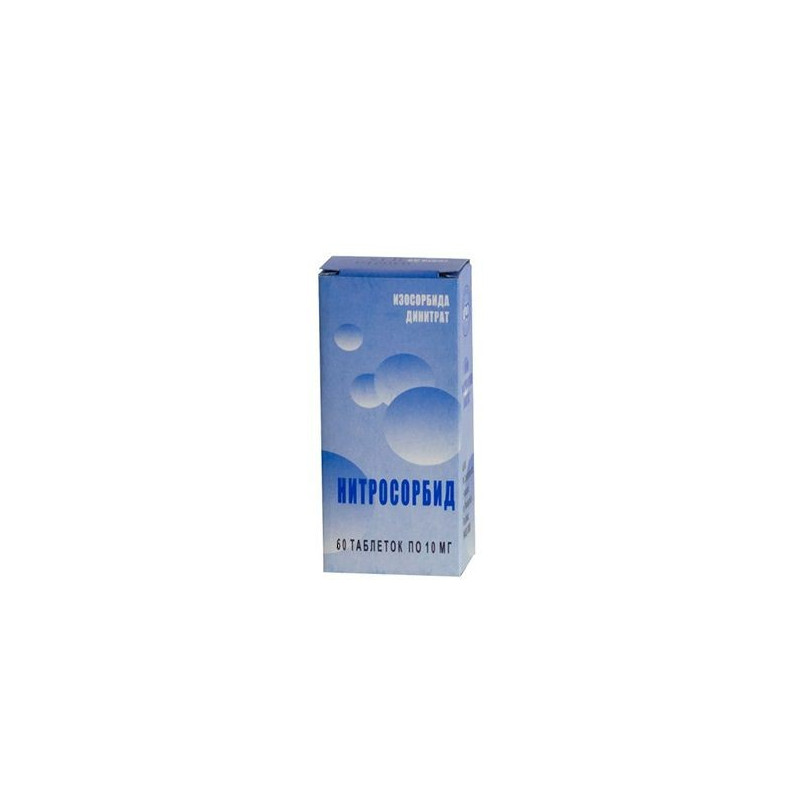



 All payments are encrypted via SSL
All payments are encrypted via SSL
 Full Refund if you haven't received your order
Full Refund if you haven't received your order
1 pill contains isosorbide dinitrate 0.01 g; in banks on 50 pieces, in a pack.
tablet mass granules; paper bag (pouch) 10 kg;
Increases the content of nitric oxide (endothelial relaxing factor) in the vascular endothelium. It has the properties of predominantly venous as well as arterial dilators. Reduces the pre-and afterload on the heart, reduces the myocardial oxygen demand, reduces the tension of the walls of the ventricles, has a coronary dilating effect, promotes the redistribution of coronary blood flow in the ischemia area, lowers the pressure in the pulmonary circulation. Causes a decrease in end-diastolic pressure in the ventricles of the heart, a temporary decrease in mean systemic blood pressure, a decrease in cardiac index. Does not change the heart rate or leads to a slight increase. Expands the vessels of the brain. Systemic vascular peripheral resistance changes slightly, resistance of pulmonary vessels steadily decreases. It helps to improve the systolic function of the heart by reducing the afterload and reflex stimulation of the sympathetic nervous system.
When ingested, it is quickly and completely absorbed, but the bioavailability is no more than 22% (due to the effect of "first passage" through the liver); with sublingual use - about 60%. Plasma protein binding is low (up to 30%). T1 / 2 - 20 min, 60 min, 4 h at IV, sublingual and oral intake, respectively. Forms two active metabolites — isosorbide – 5 mononitrate (75–85%) and isosorbide – 2 mononitrate (15–25%), which have longer half-life. Excreted by the kidneys (almost completely in the form of metabolites).
Use in the first trimester of pregnancy is contraindicated. Appointment in the II – III trimester of pregnancy is possible only under strict indications and under constant medical supervision.
At the time of treatment should stop breastfeeding.
Hypersensitivity, anemia, cerebral hemorrhage or recent trauma to the head, hemorrhagic stroke, increased intracranial pressure, angle-closure glaucoma, hyperthyroidism, shock, collapse, hypotension (low blood pressure below 100 mm Hg), myocardial infarction or heart failure with a low myocardial infarction, low heart rate, myocardial infarction; left ventricular, aortic or mitral valve stenosis, hypertrophic cardiomyopathy with obstruction of the left ventricular output tract, toxic pulmonary edema, deficiency of glucose-6-phosphate dehydrogenase, pregnancy l (I trimester), breastfeeding, child age.
Rush of blood to the face and neck, headache, dizziness, nausea, vomiting, burning sensation at the tip of the tongue, orthostatic hypotension, collapse, restlessness, stiffness, impaired attention, tachycardia, withdrawal syndrome.
Inside, before meals - 0.005–0.04 g 1–4 times a day.
Symptoms: methemoglobinemia (cyanosis of the lips and nails, anoxia), severe dizziness or fainting, collapse, pressure sensation in the head, weakness, shortness of breath, weak and rapid heartbeat, bradycardia, fever, cranial hypertension, convulsions, nausea, fever, fever, cranial hypertension, convulsions, nausea, fever, increased body temperature, cranial hypertension, convulsions, nausea, fever, increased body temperature, cranial hypertension, convulsions, nausea, fever, heart disease, cranial hypertension, convulsions, nausea, fever, heart disease, cranial hypertension, convulsions, nausea, fever diarrhea, dyspnea, visual disturbances.
Treatment: gastric lavage, symptomatic treatment, with methemoglobinemia - the prescription of methylthioninium chloride (Methylene Blue) in a dose of 1-2 mg / kg, IV.
Adsorbents, astringents and coating agents reduce absorption from the gastrointestinal tract. Antihypertensive agents (beta-blockers, Calcium antagonists, et al. Vasodilators), dihydroergotamine, procainamide, quinidine, tricyclic antidepressants, neuroleptics, Sildenafil citrate and the alcohol increase hypotension, sympathomimetics reduce antianginal effect, the combination with atropine increases the probability of increased intraocular pressure.
Care must be taken when prescribing to patients with a tendency to orthostatic hypotension.When used in patients with initially lowered blood pressure, it is necessary to combine with the administration of drugs that have a positive inotropic effect. Control of blood pressure and heart rate is recommended, especially at the beginning of treatment. At the beginning of treatment, special care must be taken to persons whose activities require rapid mental and motor responses. It is necessary to pay attention of the patient that side effects amplify against the background of alcohol intake. To prevent the development of addiction after 3-6 weeks of regular use, it is recommended to take a break for 3-5 days.
B. List: In a dry, cool, dark place, away from sources of fire.
